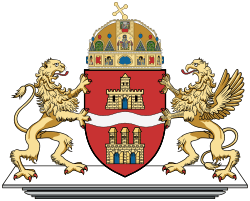Kispest
| 19th District of Budapest Budapest XIX. kerülete Kispest | |||
|---|---|---|---|
| District of Budapest | |||
| District XIX | |||
| |||
 Location of District XIX in Budapest (shown in grey) | |||
| Coordinates: 47°27′N 19°08′E / 47.450°N 19.133°ECoordinates: 47°27′N 19°08′E / 47.450°N 19.133°E | |||
| Country | Hungary | ||
| Region | Central Hungary | ||
| City | Budapest | ||
| Established | 1 January 1950 | ||
| Quarters[1] |
List
| ||
| Government | |||
| • Mayor | Péter Gajda (MSZP) | ||
| Area[2] | |||
| • Total | 9.38 km2 (3.62 sq mi) | ||
| Area rank | 18th | ||
| Population (2016)[2] | |||
| • Total | 60,731 | ||
| • Rank | 15th | ||
| • Density | 6,474/km2 (16,770/sq mi) | ||
| Demonym(s) | tizenkilencedik kerületi (“19th districter”) | ||
| Time zone | UTC+1 (CET) | ||
| • Summer (DST) | UTC+2 (CEST) | ||
| Postal code | 1191 ... 1196 | ||
| Website |
uj | ||
Kispest (lit. Little Pest) is the 19th (XIX) district of Budapest, Hungary. It lies to the south-southeast of the historical Pest city. It was founded in 1871 on rural land as a small village beside the city limits of Budapest, so it was named Kispest (Little Pest).[3] From 1880 to 1990 Kispest's population increased from 1820 to 72,838.[4] Kispest became part of Greater Budapest in 1950. The huge panel Kispesti lakótelep (Kispest microdistrict) was built in the 1980s (12,100 flats, c. 33,000 inhabitants, making it the sixth-biggest housing estate/microraion in Budapest).[5] The district is served by the Metro 3 (Kőbánya-Kispest and Határ út stations), so the connection with the Downtown is rapid. Kispest's Határ út metro station is the third-busiest in the city (after Deák Square and Örs vezér tere) with an estimated 40,000 passengers using it (often twice) on a typical workday.
Ferenc Puskás played football for Kispest F.C. (then called Kispest Honvéd FC) in the 1950s.
When the Soviet tanks and troops re-entered Budapest to subdue the civil uprising in October/November 1956, they approached the city centre from the south-east, up the Üllői Avenue, with some of the first street clashes taking place in Kispest.
Kispest is graced by an elegant residential area called Wekerletelep (named after the Hungarian premier at the time of the development in the 1920s, Sándor Wekerle). This area has much greenery. Its central square has two characteristic architectural gateways (designed by Károly Kós and based on Transylvanian building styles). In May every year an event called Wekerle Napok takes place. This involves a fun run and cycling events for all ages, a funfair, concerts, films and various other cultural and family oriented events.
Perhaps the prettiest church in Kispest is the Catholic Church of Saint Mary of the Assumption, located in Kispest town square.
Sport
- Budapest Honvéd FC, football team
- Kispesti Textil SE, defunct football team
Gallery
 The church of Saint Mary of the Assumption in Kispest
The church of Saint Mary of the Assumption in Kispest- Kispest housing estate
- A panel block next to Kőbánya-Kispest metro station
References
- ↑ "94/2012. (XII. 27.) Főv. Kgy. rendelet - a közterület- és városrésznevek megállapításáról, azok jelöléséről, valamint a házszám-megállapítás szabályairól" (in Hungarian).
- 1 2 "A fővárosi kerületek, a megyei jogú városok, a városok területe, lakónépessége és a lakások száma" [The area of districts of the capital, of the towns with county's rights, resident population and number of dwellings]. Magyarország közigazgatási helynévkönyve 2016. január 1 [Gazetteer of Hungary 1st January, 2016] (PDF). Hungarian Central Statistical Office. 2016. p. 21.
- ↑ History of Kispest (Hungarian) Archived 2009-05-21 at the Wayback Machine.
- ↑ Historical population of Kispest (Hungarian Central Statistical Office)
- ↑ Housing estates of Budapest (Index.hu, Hungarian)


